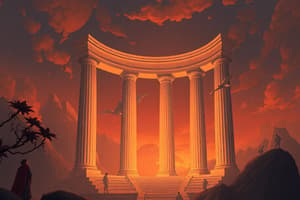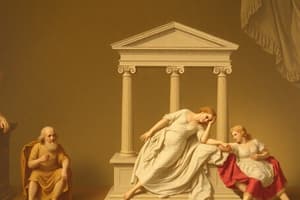Podcast
Questions and Answers
During which century did Neoclassicism originate in Europe?
During which century did Neoclassicism originate in Europe?
- 17th century
- 18th century (correct)
- 19th century
- 16th century
Which ancient styles were revived during the Neoclassical era?
Which ancient styles were revived during the Neoclassical era?
- Classical Greek and Roman styles (correct)
- Renaissance styles
- Baroque styles
- Medieval styles
When did the Neoclassical period generally come to an end?
When did the Neoclassical period generally come to an end?
- 1600s
- 1700s
- 1900s
- 1800s (correct)
What inspired artists during the Neoclassical period to imitate classical motifs and structures?
What inspired artists during the Neoclassical period to imitate classical motifs and structures?
What major historical event contributed to the rise of neoclassicism by emphasizing ideas of liberty, equality, and civic virtue?
What major historical event contributed to the rise of neoclassicism by emphasizing ideas of liberty, equality, and civic virtue?
Which intellectual movement coincided with Neoclassicism, emphasizing reason and morality over tradition?
Which intellectual movement coincided with Neoclassicism, emphasizing reason and morality over tradition?
What significant influence on neoclassicism came from archaeological excavations?
What significant influence on neoclassicism came from archaeological excavations?
Which publication contributed to the neoclassical movement by portraying ancient Rome as a model of civilization and government?
Which publication contributed to the neoclassical movement by portraying ancient Rome as a model of civilization and government?
Which artistic movement was inspired by neoclassicism and continued its influence into the modern era?
Which artistic movement was inspired by neoclassicism and continued its influence into the modern era?
What is a defining feature of neoclassical art according to the text?
What is a defining feature of neoclassical art according to the text?
In architecture, what did neoclassical designers draw inspiration from for their structures?
In architecture, what did neoclassical designers draw inspiration from for their structures?
What aspect of Western culture still shows traces of neoclassicism today?
What aspect of Western culture still shows traces of neoclassicism today?
Flashcards are hidden until you start studying
Study Notes
Neoclassicism
Neoclassicism is an artistic movement that originated in Europe during the late 18th century, primarily in Italy, France, and Great Britain. This era of art was characterized by its revival of classical Greek and Roman styles in literature, music, visual arts, architecture, and cultural thought. It was also known as the Age of Enlightenment or simply the Classical Period.
The neoclassical period began around 1750 and lasted until approximately 1800, though some scholars argue that it extended into the early decades of the 19th century. Neoclassicism was inspired by the discovery of ancient ruins and relics, which led artists to study and imitate classical motifs, themes, and structures. These new insights brought a renewed emphasis on rationality, order, harmony, clarity, and refinement in various aspects of society.
Historical Context
Neoclassicism emerged during what has been referred to as "la belle époque," a time of relative peace and prosperity following the end of the Seven Years' War in 1763. The movement coincided with the Scottish Enlightenment, which emphasized reason and morality over tradition and custom. In addition, the French Revolution contributed to the rise of neoclassicism through its ideas of liberty, equality, fraternity, and civic virtue.
One significant influence on neoclassicism came from archaeological excavations, particularly in Pompeii and Herculaneum, where artists discovered well-preserved frescoes that they emulated in their own works. Another factor contributing to this movement was the publication of Edward Gibbon's History of the Decline and Fall of the Roman Empire, which presented ancient Rome as a model of civilization and government.
Characteristics of Neoclassicism
A defining feature of neoclassicism is its dedication to clarity and simplicity, often achieved through the use of basic geometric shapes like circles, squares, and triangles. Additionally, neoclassical art frequently features a sense of balance, proportion, and symmetry, reflecting the values of reason and order associated with Enlightenment thinking.
In visual arts, neoclassical painters focused heavily on portraiture and history painting, both genres offering opportunities to demonstrate mastery of the human form and allegorical symbolism. Architecture of the time drew inspiration from Greco-Roman structures such as the Parthenon, incorporating columns, pediments, and friezes into buildings designed to showcase societal wealth and power.
The Legacy of Neoclassicism
Neoclassicism continued to influence art throughout the 19th century and into the modern era, inspiring movements like Romanticism and Realism. Today, we can still see traces of neoclassicism in various aspects of Western culture, from the design of government buildings to the depiction of classical motifs in literature and media.
Studying That Suits You
Use AI to generate personalized quizzes and flashcards to suit your learning preferences.



